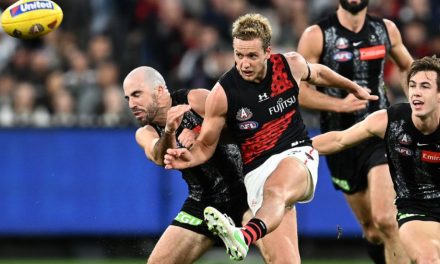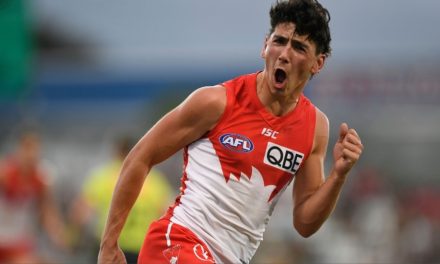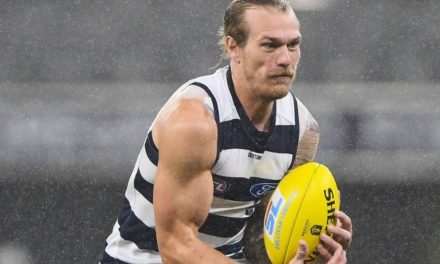Mitch Robinson points the way to the premiership for the Lions after a goal last weekend. Photo: AFL MEDIA
Perception is often slow to catch up with reality, particularly when it comes to football. We can all be guilty at times of assessing today’s circumstances by yesterday’s standards, failing to take what we’re seeing at face value.
It’s happened increasingly in recent times, and it’s happening again right now with Brisbane.
The Lions are equal on points at the top of the ladder with 14 wins, less than one point of percentage behind West Coast. They’ve won their last seven games in a row, all by at least two goals.
Brisbane’s Gabba home has again become one of the AFL’s most feared away venues, the Lions 8-1 there this season, with two games still to play there. Not that their winning run has been cushioned by a string of home games, though, four of the seven straight victories coming on the road, in Melbourne, Sydney, Adelaide and Launceston.
Check out the latest premiership odds, though, and you’ll notice that it’s Richmond and West Coast sharing flag favouritism at $3.50, with Geelong, which has now lost four of its last seven games, only a little further back at $4.50, with the Lions a long way behind that at $7.50. And that’s completely understandable.
Why? Because no-one outside Brisbane, perhaps not even the club itself, expected an upswing of this scale in 2019, and when it comes to the laws of September and finals football, anything outside the norm makes us a suspicious lot.
It’s hard to win a final if not enough of your players have experienced one. You need to lose a grand final to know how to win one. Those are just a couple of old maxims surrounding the last month of the season. Do they still apply? Did they ever?
Certainly not when Richmond broke a 24-year premiership drought over a much more experienced Geelong side all the way back in 1967.
Indeed, the Tigers hadn’t played a final of any description for 20 years until their second semi-final win over Carlton a fortnight before they beat the Cats, who were playing in their sixth consecutive finals campaign, with nearly half the line-up having played in their 1963 premiership team.
Nor the following year, when Carlton won its first premiership for 21 years at the expense of Essendon, which had won a flag only three years earlier and was competing in its fifth finals series in a seven-year period.
The “gotta lose one to win one theory” perhaps might have worked for St Kilda when it won its one and only premiership in 1966 after having lost the previous grand final. Maybe it helped North Melbourne win its first in 1975 over Hawthorn after having lost to Richmond the year before.
But it didn’t prove a great help for any of the legion of Collingwood players who were involved in any of the Magpies’ eight grand final losses between its 1958 and 1990 flags.
And more recent history is littered with examples of teams which came from seemingly nowhere to win a premiership without much of a finals apprenticeship, let alone grand final experience.
Try Essendon’s “Baby Bombers” of 1993. Adelaide in 1997-98. Sydney and West Coast in their two classic grand final face-offs of 2005-06. Hawthorn in 2008. And, of course, the Western Bulldogs of 2016, who’d finished 14th only two seasons previously, and had been in just one losing elimination final in six years before their memorable march to glory.
There’s less obvious a gap now between the finals environment and that of the regular season. Players of the 20th century spent most of their seasons playing at far smaller suburban venues with capacities in the order of 30,000, to be suddenly catapulted on to an MCG arena before 80 or 90-odd thousand people.
Big crowds these days are a lot less novel thanks to ground rationalisation, stadiums in the major football capitals holding 100, 60 and more than 50,000, and scheduling which fills the season with stand-alone drawcard games on Friday nights or “event” games coming under the gaze of a whole football nation.
Any acclimatisation issues Brisbane will have this September might have more to do with familiarity with the venue than games experience, the Lions having played at the MCG only once this year, back in round four against Essendon, when they suffered their second-heaviest defeat of the season.
To that end, Brisbane’s round 23 game against Richmond at the MCG will be invaluable. And given that the clash with the Bombers, even on a Saturday afternoon, drew nearly 50,000, a stand-alone Melbourne Sunday afternoon match might get a fair few more than that.
If the Lions then play their cards right and grab a home final, it could also well be the last time they need to deal with the “G” until grand final day, a first-up win offering a home preliminary final, unlike Brisbane’s 2004 predecessors, who unfairly had to “host” Geelong at the ground.
It’s true that Brisbane will concede plenty of finals experience to most of its September rivals. The Lions list’s aggregate finals tally of 64 games, spread among 10 players, pales alongside the likes of Geelong (229), West Coast (208) and Collingwood (204). But it’s still more than Essendon (56) will boast should the Bombers make the final eight.
And Brisbane continues to “grow” at a rapid rate of knots. The team which succumbed to Essendon by 47 points back in April and was the following week belted by 62 points at home against Collingwood is a different proposition altogether in August.
That has much to do with the younger likes of Hugh McCluggage, Jarrod Berry, Eric Hipwood, Cam Rayner and Noah Answerth having their development expedited playing in winning teams alongside the vast experience of Luke Hodge, Daniel Rich, Mitch Robinson, Stefan Martin, Dayne Zorko and Lachie Neale.
With all due respect to this week’s opponent, Gold Coast, this Saturday is a perfect opportunity for those relatively inexperienced types to take another huge swig from the vat of confidence. And football, even finals football, is more than ever now about momentum. Brisbane has as much of that at the moment as any rival.
None of this was “supposed” to happen, of course. The Lions had won five games in each of Chris Fagan’s first two seasons as coach.
But those win-loss tallies painted a very misleading picture of Brisbane’s continued development. A 2017 average losing margin of 47 points was last year almost halved, the Lions losing five games by just seven points or less. Last year also saw the addition of Hodge, as good as an on-field coach. His influence on this young group can’t be overstated.
In glorious hindsight, a team which was five goals away from a 10-win instead of a five-win 2018 was always a chance to at least give finals a shake. And now that they’re a lock, and a top four berth very likely, which can’t it realistically aspire to take the lot?
Yes, it’s hard for the bookies, for all of us hard-bitten footy types, to get our heads around. Yes, it goes against finals folklore. But yes, it really could happen.
*This article first appeared at INKL.












This is looking like the strongest top four we’ve seen in a few years. Whoever wins the flag will be the best of the best.
It’s also a year that the flag could be won from fourth – which hasn’t happened in the current top 8 system (and only two teams have even made the GF from fourth)
I think the Tigers will beat the Lions and Eagles in the next two rounds, and the Lions will beat the Cats, leaving all four on 64 points.
Geelong is hard to get a read on. Has their drop in form been because of amping up training to peak in September as rumoured?
If all the top four play at their best, I still think Richmond should win it – against whoever finishes second – thereby becoming the first team to win from fourth in this top 8 system.